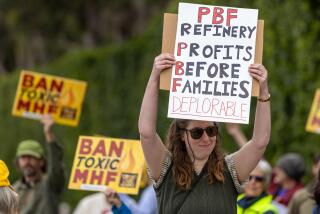Task Force Gives ‘Neutral’ Report on Usage of Acid
- Share via
A task force set up by the South Coast Air Quality Management District to study hydrofluoric acid has backed away from an earlier recommendation to permit continued bulk use of the acutely hazardous chemical with improved safety measures.
Instead, voting members of the task force, which has been meeting for two years, decided Friday to present a report to the AQMD board offering three options but making no recommendation.
In addition to the original recommendation, the other two options are to permit continued use without requiring improved safety measures and to ban the bulk use of hydrofluoric acid.
Arguing for the neutral stance, Los Angeles City Fire Capt. Richard Anderson said that as a staff member of a city agency, he did not think it appropriate to recommend what level of risk is acceptable.
All 18 voting members of the task force represent public agencies, with representatives of industry, unions and community groups serving as non-voting members on the 45-member group.
The amended task force report will be presented to the AQMD board on April 6, when the board will consider a recommendation from AQMD staff that hydrofluoric acid be phased out.
At that meeting, comments opposing a ban will be presented by industry task force members.
Mobil Oil Corp., the largest of four refineries in Los Angeles County using the substance to produce high-octane unleaded gasoline, has estimated that it would cost $100 million to convert its refinery to less volatile sulfuric acid.
The Ultramar refinery in Wilmington and the Powerine and Golden West refineries in Santa Fe Springs also use hydrofluoric acid.
In addition, Allied-Signal Inc. uses the substance to manufacture refrigerants in a plant in El Segundo; there is no known substitute for the substance in the manufacture of the refrigerants.
In late December, the task force’s draft report said that the risks of using hydrofluoric acid at refineries and at Allied-Signal could be made acceptable if industries enhanced safety measures such as water sprays and monitoring devices.
Two weeks later, the AQMD staff reached the opposite conclusion, saying that human error, earthquake dangers and sabotage posed uncontrollable dangers that could be avoided if hydrofluoric acid was phased out.
Industry-sponsored tests in 1986 showed that a 1,000-gallon, two-minute spill of hydrofluoric acid could be lethal as far as five miles downwind.
AQMD computer modeling of a major release--based on a 1987 refinery accident in Texas--subsequently predicted that hydrofluoric acid vapors would reach dangerous concentrations in populated neighborhoods even if control systems functioned properly. The study also said that a similar spill involving sulfuric acid posed a far smaller risk.
Industry officials argued that the AQMD study is overly pessimistic and that risk assessment studies predict that a major release of the sort used in the computer study are so unlikely as to be not worth worrying about.
But at the meeting Friday, AQMD Deputy Executive Director Ed Camarena said that accidents have occurred that risk assessment techniques predict would happen only once in a million years.
More to Read
Sign up for Essential California
The most important California stories and recommendations in your inbox every morning.
You may occasionally receive promotional content from the Los Angeles Times.












